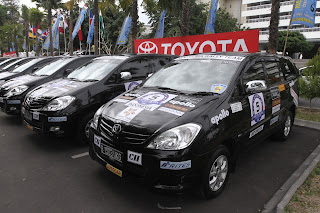The 2nd edition of the ASEAN-India Car Rally (AICR) was held from 25 Nov to 21 Dec 2012. Starting from Yogjakarta (Indonesia), the Rally passed through Singapore, Ipoh, Hat Yai, Phuket, Bangkok, Siem Reap, Phnom Penh, Ho Chi Minh, Pakse, Savanakhet, Vientiene, Chumphone, Sukhothai, Hpa An, Nay Pyi Taw, Mandalay, Ka Lay, Kohima and Guwahati (India). India Prime Minister Dr. Manmohan Singh and the Heads of State of all ASEAN nations witnessed the ceremonial flag-down at the Rally’s final stop in New Delhi.
A total of 31 SUVs, kindly provided through the
generosity of Mahindra & Mahindra, were shipped from India to Singapore
prior to the start of the Rally. The recently launched Mahindra XUV 500 made up
28 units of the convoy, driving rally officials, media crew and participants
from India and 10 ASEAN countries. An older model, the Mahindra Scorpio, made
up the remaining 3 units which served as support/service vehicles.
The Singapore team was allocated Car #22 (which is equipped with AWD) and #23
(FWD) for the Rally. As seen below, the jaw-like front grill of the XUV 500 is
an expression of the cheetah-inspired design described by the manufacturer.
(Note the automatic folding door mirrors)

All 31
Mahindra SUVs travelled more than 7,500km without a breakdown. Barring the
occasional minor adjustments and tightening (due to loose hose, joints, wire
etc.), which were carried out during rest stops, the vehicles from Mahindra
& Mahindra proved to be very reliable.
This feat is all the more
respectable considering the cars were exposed to punishing conditions on
several occasions.
Although the
XUV 500 is similar to the SsangYong Rexton in terms of weight and size, it
offers a more car-like handling. The 2.2 litre turbo diesel engine may lack
refinement for city driving but it is sufficiently strong with useful torque
ranging from 1,800 rpm to 3,000 rpm. This suits the rally road conditions which
include rather steep climbs. Best of all, the pocket-friendly fuel consumption
(12.8 km/litre for Car #22; 14.1 km/litre for Car #23) will appeal to the
masses.
For a successful global market penetration, the XUV 500 would need to provide potential buyers with an optional automatic transmission and overall improved quality control. According to the locals, these issues have been or will be addressed by the middle of next year.
The Kijangs that were used in the Rally were powered by a 2.0-litre gasoline engine with 5-speed manual transmission. With its mass appeal look, decent performance and trusted Toyota quality, it is no surprise that the car is highly popular in various parts of Asia.




